| |
|
| |
 |
| |
HOME |
RESEARCH |
PUBLICATION |
CONTACT
|
| |
Mohamed Gharib
|
|
Introduction:
Multiple impact problems arise in many practical applications, such as
airplane undercarriages, impact crushers, and assembly robots. Solution
of rigid body impact problems that involve simultaneous collisions is a
challenging problem in mechanics and dynamics. This problem was studied
by many researchers and several models were introduced; most notably the
Impulse-Momentum and the Compliance contact theory based methods. These
two methods have been around for many years but only few models produce
energetically consistent solutions. The two approaches yield similar
solutions for elastic and nearly elastic collisions, yet can diverge
significantly for inelastic impacts. One can find few experimental
studies that address multi-impact problems. |
|

Impact-Contact models
|
Correlation between
Impulse and Compliance Based Methods in Rigid Body Collisions:
In this work, we numerically solved the two ball inelastic impact
problem using the impulse momentum and the compliance based models. We
also established a correlation between the coefficient of restitution
(in the impulse momentum model) and the contact stiffness (in compliance
models). Two correlations were obtained. The former correlation for the
compliance models with hysterias damping and the other one is for the
compliance models with permanent indentation. In the first correlation,
we used the force end condition to derive a new relationship for the
damping factor. In the latter correlation, we used the definition of the
energetic coefficient of restitution to derive a relationship among
coefficient of restitution and the compression and restitution
stiffness. The numerical results showed that the impulse momentum and
the compliance model with permanent indentation produce identical
results. While the common compliance model with hysteresis damping is
valid only for nearly elastic impacts (e > 0.9). The new
model proposed here produces good agreement for cases with a lower range
of coefficient of restitution (e < 0.4). |
|
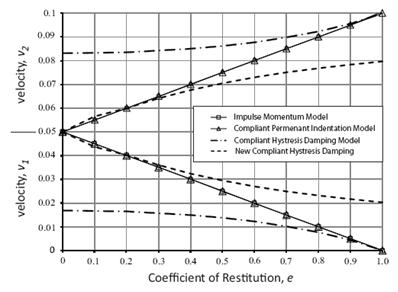
Final velocities comparison for different impact/contact models
|
|
Solving the
frictionless multiple impact problem using the Impulse Momentum and
Compliance Based Methods:
In this work we numerically solved the multiple impact problem in a
linear chain composed of elastic balls. Two methods were used, the
impulse momentum method and the Hertz contact theory based method. We
compared the post impact velocities from the two methods and the results
showed that the methods produce similar solutions for elastic impacts.
Hence one can use the Hertz contact theory based method to determine the
impulse correlation ratio (ICR), which is an essential parameter in the
impulse momentum method in elastic collision. |
|
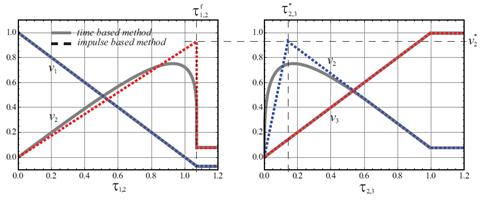
Velocity-Impulse diagrams for three steel balls
|
|
Solving frictionless rocking block problem with multiple
impacts:
In this work, we developed a new approach to solve the multiple impact
problem of a rocking block. The methodology is based on the use of
impulse–momentum methods. The approach uses the ICR that was developed
previously to solve the multiple impact problems in a linear chain of
balls (Ceanga
& Hurmuzlu 2001).
The method also uses the energetic coefficient of restitution and yields
energetically consistent solutions.
We have analyzed the
separation of the non-contacting end. Then, we have derived a parameter
map in terms of the surface inclinations and the height-to width ratio.
It has been shown that one may have single and/or simultaneous
multiple collisions at the surface contact points. Finally, a set of
experiments were conducted to demonstrate the validity of the proposed
methodology. We have shown that the experimental outcomes agree with the
theoretical results. In addition, as far as the separation at the
non-contacting end is concerned, the experiments exhibit the same trend
that is predicted by the theory. The problem considered in this study
was simplified by neglecting friction at the contact points. This was a
necessary simplification at this initial stage of the development. Yet,
including friction would be a good natural step for future research
efforts. |
|
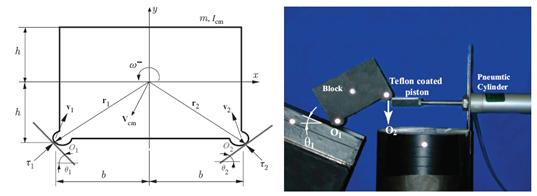
Rocking block modeling and experiment
|
|
Solving
the Baton Problem using Impulse Correlation Ratio:
This work presents the solution of the impact problem for a
sliding/bouncing baton on flat and inclined planes considering the
surface friction. The baton is assumed to have unilaterally constrained
motion, which means one end slides on the ground while the other end
collides with the ground. We use the impulse momentum approach and
incorporate the impulse correlation ratio (ICR) hypothesis to solve the
ground impact problem when the system has unilaterally constrained
dynamics. Parametric investigations carried out to examine the effect of
the baton's length and the inclined wall slope angle on the impulse
correlation ratio. Numerical simulation and experiments carried out to
validate the model. |
|
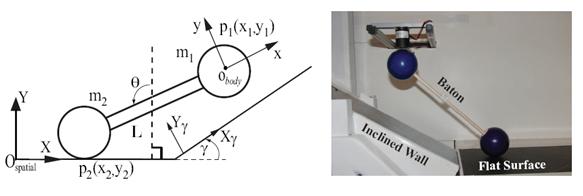
Baton modeling and experiment
|
|
Multiple Impact Based
Energy Absorption:
In this work, we proposed a scheme for energy absorption using a linear chain
of steel balls. This scheme relies on dissipating the kinetic energy by
using the appropriate arrangement of large and small balls. The
numerical results showed that placing one or more small balls between
the large balls will result in high energy absorption (84%). We propose
to use one small ball placed between every pair of large balls, which
roughly results in 80% energy absorption. Single small ball versus
multiple small ball placements simplifies the design and resolves
alignment problems. Also, we examined the effect of the coefficient of
restitution and we found that using steel balls (e = 0.94)
is efficient for most applications. Finally, we showed that increasing
the number of large balls will lead to extra energy absorption. From the
point of view of energy dissipation, the benefit of increasing the
number of large balls diminishes as we increase the size of the chain.
The adverse effect of increasing the number of balls is creating a
bulkier shock absorber. A set of experiments was done for 3Large- 2Small
and up to, 7Large-6Small balls. The results clearly demonstrate that the
experimental outcomes are in agreement with the theoretical results. |
|

Energy absorption linear chain experiment
|
Solving Particular
2D Multiple Impact Problems Using the Impulse Correlation Ratio:
In this work we developed a new approach to solve the non-frictional
multiple impact problems that arise in a specific set of two dimensional
cases. The approach uses Impulse Momentum based method, the Energetic
Coefficient of Restitution, and the Impulse Correlation Ratio (ICR)
hypothesis.
We presented a solution method for the collision of one ball that
strikes one end of a stationary ball in contact with: (i)a third
stationary ball placed at an arbitrary angle
θ,
and (ii)two identical balls placed symmetrically at angles
±θ.
First, we proved the existence of the ICR by considering springs on the
contact points. Then, the solution method was generalized to solve the
impact problem in three general cases: (a)a linear chain of r
balls with one tilted chain of N-r balls placed at an
angle
θ,
(b)a linear chain of $r$ balls with two symmetrically tilted chains each
with N-r balls and placed at angles
±θ,
and (c)a triangular arrangement of balls similar to those in the pool
game but not with limited number of balls. Finally, a set of experiments
were conducted to demonstrate the validity of the proposed methodology.
We have shown that the experimental outcomes agree very well with the
theoretical results. The problem considered in this study was simplified
by neglecting friction at the contact points. Also, the two branches and
the triangular configurations were assumed to have identical balls and
placed in symmetrical configurations. This was necessary simplifications
in this initial stage of the development. |
|
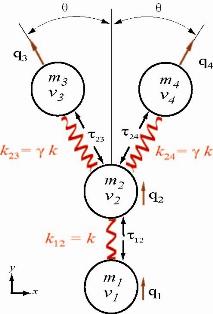
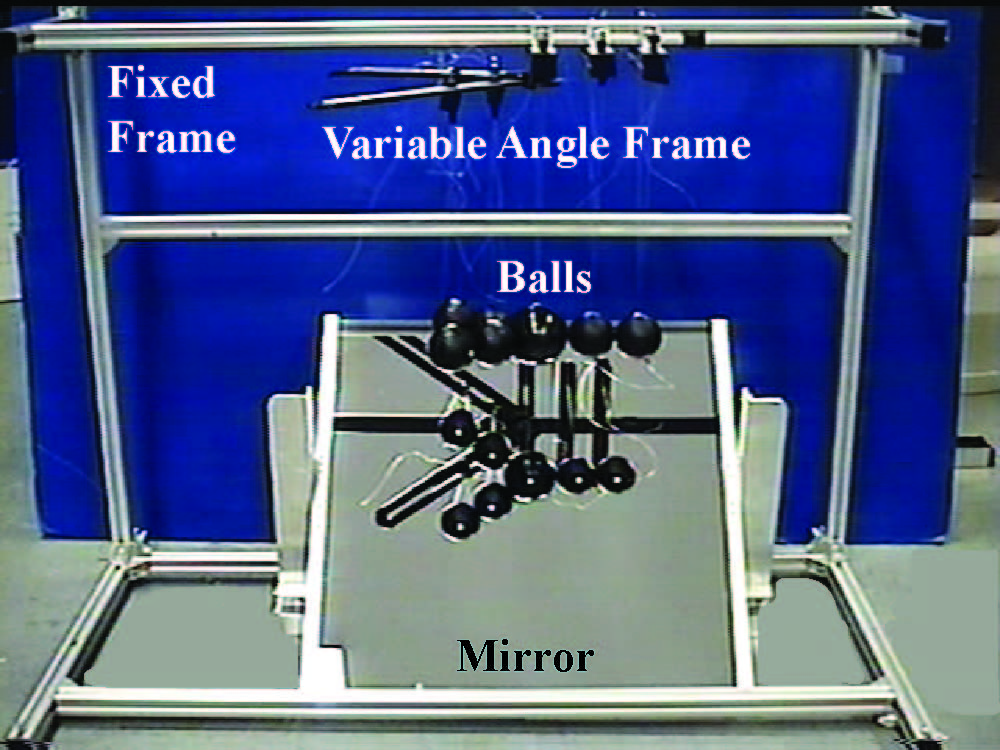
Two
dimensional multiple impact modeling and experiment
|
|
Elastic Impact of
Spheres on Large Rectangular Plates:
In this work, we numerically solve the elastic impact problem of flat
plate resting on a linear chain of spherical balls. The system’s
governing equations are derived using the Hertz contact theory based
approach. We use numerical analysis to demonstrate that one can obtain a
very high number of intermittent collisions in the chain by placing
small balls between the larger ones. Increasing the number of collisions
significantly increases energy absorption due to impact. We exploit this
feature to develop an impact based vibration suppression scheme of
rectangular plate. |
|
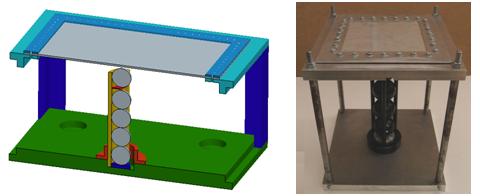
Plate vibration damping experiment
|
|
Ultrasound attenuation using spherical particles with different sizes:
In this work, we present an experimental study of ultrasound wave
propagation in granular media made of poly sized spherical beads packed
in a rigid container and randomly arranged. Two cases have been
considered, the case with air is the surrounding medium, and the other
case with oil surrounding medium. The results show that using different
size spherical balls can achieve significant wave attenuation
in ultrasound regime. Also, the medium surrounding the particles is
highly affecting the wave transmission. The mass ratio effect has been
studied for the spherical lead shots used in the experiments. |
|
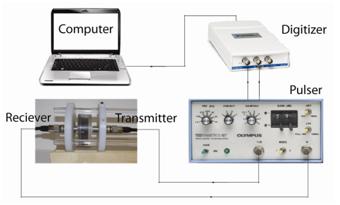
Ultrasound attenuation experiment
|
|
Last Update: May 2011
|
|

HOME |
RESEARCH |
PUBLICATION |
CONTACT |


